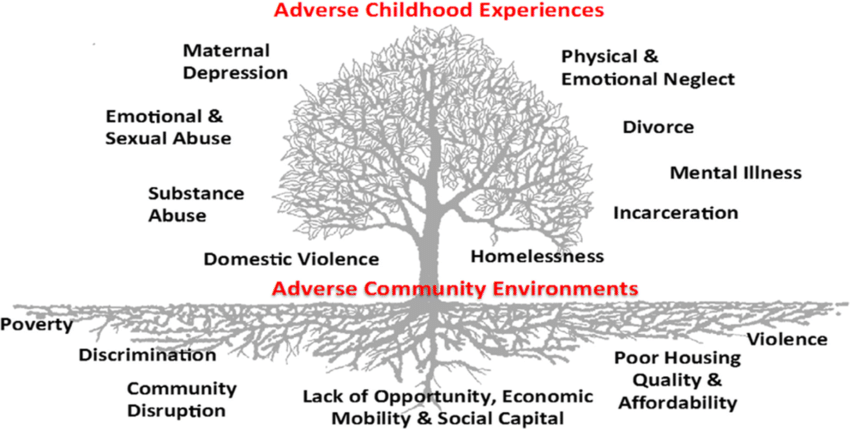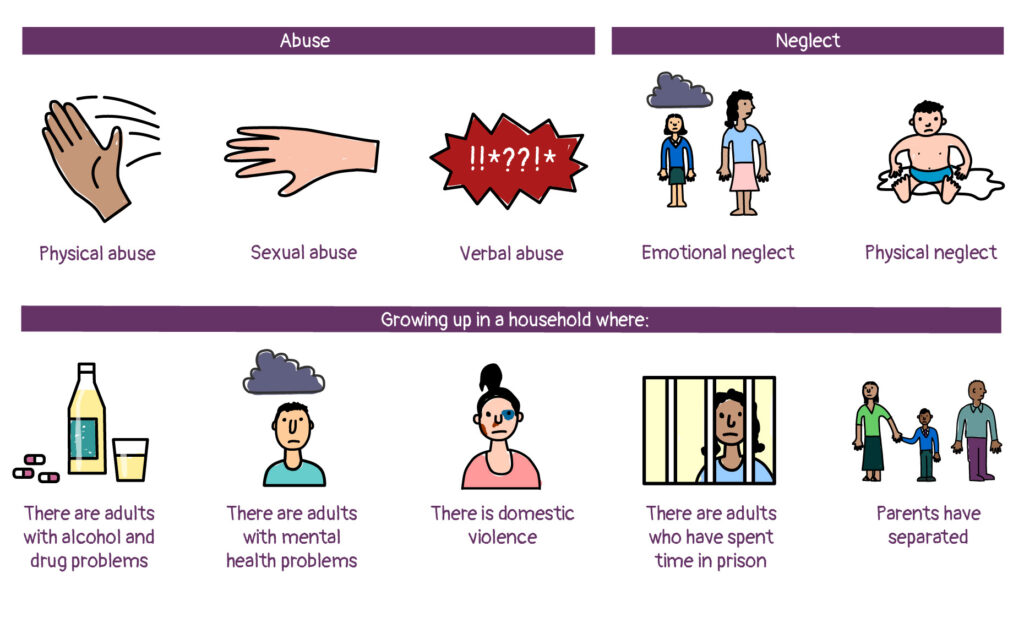![]()
Update Chrome Browser
Childhood exposure to prolonged traumatic events may result in a toxic stress response, negatively affecting a child’s brain development. These disruptions increase the risk of poor physical health, coping skills, or other long-term cognitive impairments. Researchers and practitioners across many disciplines (e.g. development psychology, pediatrics, social work) had general knowledge of the connection between trauma and healthy development, however the 1998 landmark study by the Centers for Disease Control and Prevention (CDC) and Kaiser Permanente (ACEs Study) deepened this understanding.
The ACEs Study examined the effects of childhood trauma and stress on adult health outcomes. In this study, adverse childhood experiences were defined within ten categories: physical abuse, sexual abuse, emotional abuse, physical neglect, emotional neglect, violence against a mother, parental divorce, household member with substance use/abuse issues, household member with mental illness, and incarcerated household member. Overall, the researchers found that child adversity is common and exposure to one or more ACEs increases an individual’s risk of physical health, psychological, and social problems in adulthood. The pervasiveness of ACEs and their impact on various aspects of an individual’s life initiated a public health response to address this problem.
of respondents in the initial ACEs study reported experiencing at least one adverse experience. ?
of respondents in the initial ACEs study reported experiencing two or more adversities.?

The Pair of ACEs tree helps illustrate the issues we aim to address when tackling ACEs. There are several
strategies that can reduce or mitigate ACEs in our community. The CDC lists a number of strategies that
aid in reducing or preventing ACEs. They are strengthening economic support to families, promoting
social norms that protect against adversity and violence, ensuring a strong start for children, teaching
skills, connecting youth to caring adults and activities, and intervening to lessen immediate and long-
term harms.
It is essential to understand that ACEs are preventable and that those who experience childhood adversity are not doomed to negative outcomes in their lives– adversity is not a destiny. Positive Childhood Experiences, or PCEs, have a favorable effect on healthy development and wellbeing and can prevent or mitigate ACEs. The Health Outcomes From Positive Experiences (HOPE) framework highlights PCEs in four categories being in nurturing, supportive relationships; living, developing, playing, and learning in safe, stable, protective, and equitable environments; having opportunities for constructive social engagement and connectedness; and leaning social and emotional competencies. This work can help build our collective understanding of preventing ACEs and building resilience.
Importantly, ACEs are preventable. Central to child adversity prevention is creating safe, stable, nurturing relationships and environments for all children and families.
When children show healthy development in spite of adversity, it is called Resilience. Fostering
resilience in young children requires strengthening the family, the community, as well as children’s own
personal resources. Children are dependent on others for their survival, and family, peers, schools,
neighborhoods, and communities can provide resources that promote resilience. The quality of the
systems and supports in a child’s life can greatly assist children’s resilient recovery. Resilience may be
fostered in children who have a strong, positive relationship with a primary caregiver who acts to ensure
safety and protection after a traumatic event.
Children who have experienced complex trauma often have difficulty identifying, expressing, and
managing emotions, which can lead to their responses being unpredictable and/or explosive. Children
who are exposed to complex trauma face numerous risks, including the risk of being abused and
neglected. Children who are chronically exposed to trauma often have difficulty forming positive,
healthy relationships, may over-respond or under respond to situations in their environment, learn to
disassociate as a defense mechanism, form a negative view of the world around them and their own
self-worth, and lack the ability to link consequences with their actions. Traumatic experiences in
childhood have been linked to increased physical and mental health issues that can last into adulthood.
ACEs-Illustration

– Human Road focuses on children-based research and programs.
– Support parents and caregivers.
– Provide training and professional development in trauma-informed care.
– Promote community awareness of ACEs.
– Advance policies and practices that help children and families thrive.
Research indicates that childhood exposure to one or more ACEs can have long lasting, negative effects on an individual’s health, wellbeing, and opportunity. ACEs may impact a person’s physical health associated with diabetes, cancer, a compromised immune system and chronic health problems later in life. Childhood adversity also affects mental health, leading to depression, substance abuse. Additionally, ACEs lead to social/behavioral issues, including poor social development, unhealthy coping behaviors, engagement in risky behaviors or violence.
ACEs are costly to community; the economic and societal burden of childhood adversity are upwards of
hundreds of billions of dollars annually. Specific to child abuse and neglect, there are also enormous
societal costs involved. A 2018 report estimated the lifetime economic burden of substantiated child
abuse and neglect cases and child fatalities is approximately $592 billion in the United States. Costs due
to ACE-attributable cardiovascular disease are substantially higher than for other causes of ill health.
Annually in the United States, each adult with a history of ACEs costs an additional $589 in healthcare
expenses, and 0.0224 DALYs valued at $5,769.
The ACE Study and subsequent research indicates that ACEs are common. In the initial ACEs Study, researchers found that nearly two-thirds of respondents reported experiencing at least one adverse experience and about 40% reported exposure to two or more adversities., ACEs have a relationship with negative outcomes — where the number of childhood adversities experienced increases the likelihood of health risks.
Building upon this work, researchers sought to gather a nationally representative sample to further understand the effect of ACEs. Each year the CDC collects ACEs data in participating states through the Behavioral Risk Factor Surveillance System (BRFSS). The BRFSS is an annual phone survey of adults over the age of 18. The findings of BRFSS are similar to those in the ACEs study– ACEs are widespread, prevalence, and associated with poor outcomes.
Yes, Positive Childhood Experiences, or PCEs, have a favorable effect on healthy development and wellbeing and can prevent or mitigate ACEs. The Health Outcomes From Positive Experiences (HOPE) framework highlights PCEs in four categories being in nurturing, supportive relationships; living, developing, playing, and learning in safe, stable, protective, and equitable environments; having opportunities for constructive social engagement and connectedness; and leaning social and emotional competencies. This work can help build our collective understanding of preventing ACEs and building resilience.
Research indicates that childhood exposure to one or more ACEs can have long lasting, negative effects on an individual’s health, wellbeing, and opportunity. ACEs may impact a person’s physical health associated with diabetes, cancer, a compromised immune system and chronic health problems later in life. Childhood adversity also affects mental health, leading to depression, substance abuse. Additionally, ACEs lead to social/behavioral issues, including poor social development, unhealthy coping behaviors, engagement in risky behaviors or violence.
There are several limitations to the ACEs framework, including limitations of the original definitions used and the ACEs screening. While the 10 original categories reviewed in the ACEs Study were important for our collective understanding of the prevalence of childhood adversity in our community, they are not broad enough. Many researchers advocate for adding other adverse experiences, such as poverty, peer victimization or rejection, exposure to community violence, among others to the ACEs assessment in order to understand ACEs more comprehensively.
The ACEs questionnaire should not be used as a screening instrument. While the tool provides information on the prevalence of ACEs, it provides little else. Instead, it is important for the field to shift efforts into understanding and establishing evidence-based intervention and prevention efforts pertaining to ACEs.
It is essential to understand that ACEs are preventable and that those who experience childhood adversity are not doomed to negative outcomes in their lives– adversity is not a destiny. Positive Childhood Experiences, or PCEs, have a favorable effect on healthy development and wellbeing and can prevent or mitigate ACEs. The Health Outcomes From Positive Experiences (HOPE) framework highlights PCEs in four categories being in nurturing, supportive relationships; living, developing, playing, and learning in safe, stable, protective, and equitable environments; having opportunities for constructive social engagement and connectedness; and leaning social and emotional competencies. This work can help build our collective understanding of preventing ACEs and building resilience.
Because Childhood Lasts a Lifetime… We Must Work Together to Keep them Safe!
Human Road; is a 501(c)(3) not-for-profit organization.
USA – EIN number: 92-2367542.
Iraq – DNGO number: 1N1812016.
Copyright © Human Road, 2023.
Privacy Policy
Our efficiency maximizes your gift’s impact.